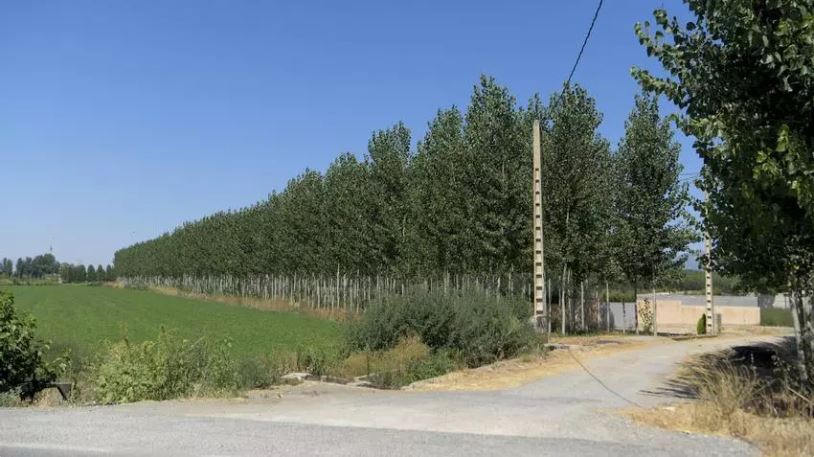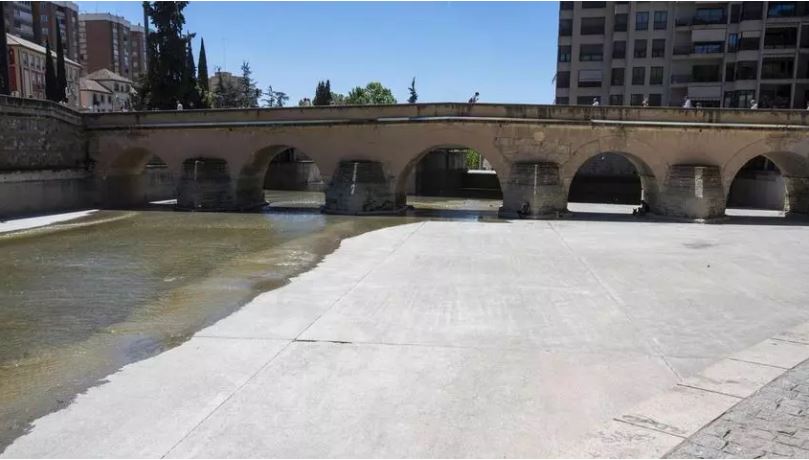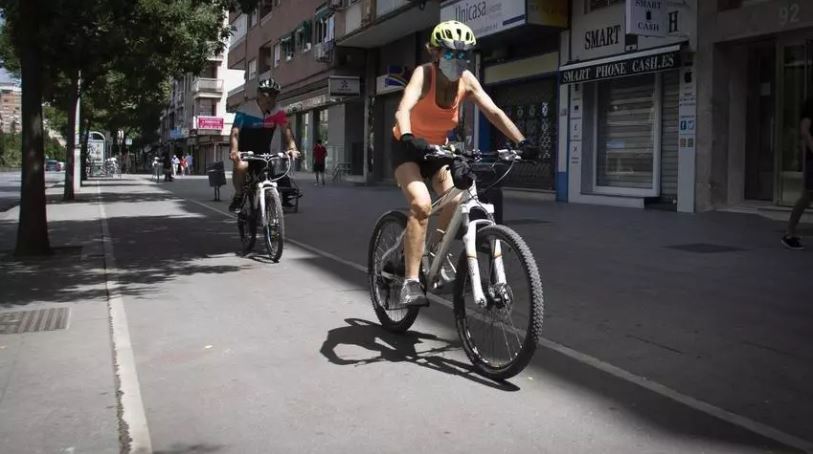



Link to the news in the newspaper Granada Hoy:
The LIFE Wood For Future project and IFAPA researchers have studied for two years the temperatures in different poplar groves in the Vega in comparison with urban green areas, to study whether its implementation in these environments would be beneficial.
Three out of four inhabitants of Granada live in areas with a vegetation index lower than recommended.
Granada is a city in which vegetation is largely absent. Asphalt and cement tend to be the protagonists of the streets and roads, and there are few places of thermal comfort in the capital to try to alleviate the very high temperatures that are recorded, increasingly higher and longer in time. People resort to shopping malls or flee in search of areas with milder temperatures, such as the Costa Tropical or inland municipalities.
However, it is possible to fight against this phenomenon with a tree deeply rooted in the popular imagination of the people of Granada: the poplars. This tall deciduous species could help lower the temperature in the streets and squares of the city, as well as in the different green areas of the Center, reducing the thermometer up to four degrees less. In addition, their ability to cool the environment and reduce pollution thanks to their ability to capture carbon dioxide and polluting particles is another of the environmental advantages of poplar trees.
This is the main conclusion of a study carried out under the European program LIFE Wood For Future, financed by the European Union, which is being developed in Granada, and which seeks the recovery of poplar trees in a circular economy environment, in such a way that they are planted by farmers, help the environment and serve as sustainable material in future constructions.
Within this extensive project, financed with more than 3.5 million euros, research has been carried out on how poplars could influence the temperature in urban areas. The researchers have been measuring during the last two years the temperatures recorded in different types of poplar trees in the facilities of the Andalusian Institute for Agricultural, Fisheries, Food and Ecological Production Research and Training (IFAPA) in Granada, as well as in other wooded areas, in green areas of Granada and in urban areas. A work that has left the researchers with approximately 35,000 data, and the belief that poplars could help to lower, and a lot, the temperatures in the streets of Granada.
David Hidalgo, professor at the School of Building Engineering at the UGR and member of the LIFE Wood for Future project, has assured this newspaper that including poplar trees in the streets and squares of Granada, as well as in existing green environments, can reduce surface temperatures by up to four degrees. “There are numerous studies that highlight that urban green areas minimize the surrounding temperatures between one and three degrees. But this study has made it clear to us that if we could include poplar trees in them, the temperature could be reduced by even one degree more, down to four degrees, which is the difference in temperatures that we have recorded between the poplar trees we have at IFAPA and those that are mixed with other trees and herbaceous plants.”
“One degree less, taking into account the high temperatures that are recorded lately in the cities, is a fact that does not seem important, but in reality it is. Poplar trees have proven to have a greater capacity to minimize temperatures than other species used in Granada for green areas or adjacent areas in urban areas,” he said.
For this reason, the LIFE project considers that it would be important to start considering them as a real option when renaturalizing and improving the urban and green areas of Granada, and thus eliminate the traditional image of the tall poplar trees planted in the Vega de Granada to adopt them as one more tree among the urban species that are usually found in the capital of Granada.
Naturalizing the city with poplars
In order for poplars to help minimize temperatures, it would be necessary to implement them in Granada in two ways: both in existing green areas and in the streets and squares of the center through different processes of renaturalization, a trend that is increasingly being carried out in Europe. Cities such as Paris or Barcelona already apply these models.
In the case of poplar planting in green areas, thanks to measurements and various studies, a drawback has been detected: the temperature reduction that these trees could help to achieve is only noticeable when they are located in areas of up to 70,000 square meters. The larger the area, the less the temperature drops, according to data from the LIFE project.
“We have to try to include poplar trees in existing green areas. But there is a drawback. In a study we did last year in Granada, we came to the conclusion that green areas with a surface area of up to 70,000 square meters, the temperature is proportional. The larger the surface area, the lower the temperature minimization. It would be an option to try to implement poplar trees in green areas in urban areas, but up to a certain area,” said Hidalgo.
However, where the drop in temperatures can be felt, and very much so, is in urban environments. Turning every street or sidewalk into a small green area, also trying to follow the rule of thumb known as the ‘3, 30, 300 Rule’, which proposes the design and management of the urban forest and the greening of cities based on three fundamental criteria, prioritizing the presence of green areas. These are that all citizens should be able to see at least 3 trees from their homes; the second says that 30% of vegetation cover or tree canopy should be provided in each neighborhood; and the third that there should be 300 meters of distance from the home to find quality green spaces.
“In some cases, the design of the city would have to be modified, because it would not be as simple as opening a one-square-meter alcove, planting a poplar tree and that’s it. We would have to seek to open a kind of canals and implement small green areas equal to the length of the streets. Paris or Barcelona, with the superblocks project, are already doing it. Every nine blocks, all the interior streets were converted into green and pedestrian zones. The ultimate goal is to naturalize the streets and turn them into small green areas,” Hidalgo emphasized.


Is it possible to renaturalize Granada?
The project to renaturalize Granada is something that has been on the table on many occasions in recent years. Many environmental organizations and political parties have talked about it in recent years, but it has remained just that. Words. Attempts have been made, such as the renaturation of several hard downtown squares like Caleta, but a project of this dimension has never been proposed.
However, Hidalgo has encouraged to initiate a change that may sound difficult now, but that in the future will end up coming. “I am committed to making decisions. We have to solve the problems of the population, and climate change is one of the most important problems we face. Reducing traffic and changing some areas to pedestrian would not be bad,” he said.
“When there is a will, even if there are difficulties, things can be done. It may be more or less costly, more or less popular, but I think you have to be brave and take action. The climatic conditions that have been developing in recent years, especially in summer, are taking us to limits that we have never known before. That is why it is necessary to take measures”, said the researcher.
As an example, the researcher has proposed an intervention in the current Camino de Ronda, where there are hardly any loose trees in the tree wells, which would be based on reducing a lane of traffic, widen the sidewalk and put in that sidewalk some large green areas, which could help reduce the temperature by two or three degrees. And if it is with poplars, all the better. “These are unpopular measures, because we are used to driving cars, but I think that with a good collaboration and a good planning of mobility and public transport we could adapt to the new conditions”, he remarked.
Another melon still to be opened in this sense is the renaturation of the Genil River, about which there have been several projects that have not ended up going ahead. The poplars could help to renaturalize this orchard area, reducing temperatures and providing very powerful shade in summer, thanks to the heights that these trees usually reach.
“When we talk about this species, which seems to lower the temperature more than others with different trees, we would like it to be included in any project to be developed in Granada. One of them can be this future project of the Genil, or even in other areas of the Darro River within the great green corridor that is proposed. In the end, Granada followed the tendencies of European cities to cover the rivers, and this is now being reverted, opening those rivers. Letting the rivers be areas of dispersion to which you can go to be at ease and refresh yourself is also possible in Granada, you just need will,” said the researcher.
Measurements in urban areas to ratify the hypothesis.
The conclusion of the reduction of poplar tree temperatures has been obtained by crossing the data recorded in the IFAPA facilities and those obtained in the Almunia Park and in the Zaidín neighborhood. “We know that the closest measurement to reality would have been in the center of Granada, because it is where the temperature is higher, but the problem lies in not having a place where to place the probe with security that will not be damaged or stolen,” said the researcher.
The poplar trees that have been measured have been three and are located in the IFAPA facilities, in the Camino de Purchil. The three have different conditions. One of them is watered every week, another every 10 days and another every 15 days. To control their conditions and check if irrigation could affect the growth of the trunk for future uses. However, irrigation has not affected data collection, and all three have yielded similar temperature information.
“The next step we want to implement is to talk to the Granada City Council and look at the possibility of planting poplar trees in urban areas, in order to be able to measure and compare equal elements. We cannot compare the temperature of a poplar tree that is outside an urban area with an urban area. That would be the next step,” Hidalgo concluded. However, it is possible, based on these data, to draw the conclusion that poplar trees would reduce the temperature in the city.
Five companies from Granada have been the winners of the twelfth edition of the Emprendemos Awards in Granada. This initiative, promoted by the Ministry of University, Research and Innovation through Andalucía Emprende, recognized these companies for the innovation they apply to the development of their activities, their growth potential, and their social, economic, and environmental impact.
The meeting will present the results of the LIFE Wood for the Future project, which ends in September of this year. . Representatives of forest owners from all the autonomous communities will meet at the Hotel Luna today and tomorrow.
The 26 photographs selected in the contest organized by the University and the Marjal Producers Association, together with a sound installation, are part of the exhibition at the Galería del Carmen of the Alhama Town Hall.
Organized by the University of Granada, through Medialab UGR of the Vice-Rectorate for Social Innovation, Employability and Entrepreneurship, in collaboration with Salvemos la Vega - Vega Educa and the City Council of Huétor Vega.
This web uses cookies
We use necessary and optional cookies to give you the best possible experience. Click accept to continue shopping or learn more about our cookie policy here.
You have already selected your cookie preferences in previous sessions. Do you want to modify them?
Obligatory cookies
They are those that allow the user to navigate through the web page, and use the different options or services that exist in it, such as, for example, identifying the session, accessing restricted access parts, carrying out the purchase process of an order or use security elements while browsing.
View the cookies we usePersonalization, analysis or functional cookies
They are those that allow the user to access the service with some predefined general characteristics based on a series of criteria in the user's terminal, such as the language, the type of browser through which the service is accessed, the regional configuration. from where you access the service, quantify the number of users and thus carry out the statistical measurement and analysis of the use that users make of the service offered. For this, your browsing on our website is analyzed in order to improve the offer of products or services that we offer you.
View the cookies we useAccept:
Advertising or informative cookies
They are those that allow us to manage our information in the most efficient way possible, adapting its content to the user's preferences, the type of terminal from which the service is accessed, the characteristics of the use made by the user of the services, offer you own or third party advertising, etc. To do this, we analyze your Internet browsing habits to offer you advertising related to the interests of your browsing profiles.
View the cookies we useAccept:
Analytics cookies
They are those that allow us to collect information on the use made of the website.
View the cookies we useAccept:

